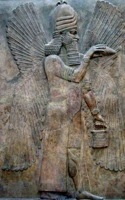Chaldean
Origin
Latin Chaldæus = Greek Χαλδαῖος Chaldean, Chaldaea, an astrologer
Definitions
- Noun
- 1.one of an ancient Semitic people that formed the dominant element in Babylonia.
- 2.the indigenous Semitic language of the Chaldeans, Aramaic being used as an auxiliary language.
- 3.Biblical Aramaic.
- 4.an astrologer, soothsayer, or enchanter. Daniel 1:4; 2:2.
- Adjective
Description
Chaldea or Chaldaea (Arabic كلدان, Kaldān[1][2]), "the Chaldeans" of the KJV Old Testament, was a marshy land located in Southern Iraq and Kuwait which came to rule Babylon. Tribes of settlers who arrived in the region in 625-539 BC became known as the Chaldeans.
The 11th dynasty of the Kings of Babylon (6th century BC) is conventionally known to historians as the Chaldean Dynasty. Their kingdom in the southern portion of Babylonia lay chiefly on the right bank of the Euphrates. Though the name came to be commonly used to refer to the whole of Mesopotamia, Chaldea proper was the vast plain in the south formed by the deposits of the Euphrates and the Tigris, extending to about four hundred miles along the course of these rivers, and about a hundred miles in average width.
The land
Chaldea was an ancient name for the marshy lands in the far south of Mesopotamia, at the head of the Gulf Persian Gulf – present day Iraq and Bahrain. It is called in Chaldean mat Kaldi — that is, "land of Chaldea" — but there is also used, apparently synonymously, the expression mât Bit Yakin. It would appear that Bit Yakin was of the land; and the king of Chaldea is also called the king of Bit Yakin, just as the kings of Bab the estuaries of the Tigris and Euphrates, which then discharged their waters through narrow bonds and obtained the ascendency over all Babylonia.
In 652 BC a series of wars broke out in the Assyrian Empire over who should rule. These wars greatly weakened the empire. Sensing this weakness, the Chaldeans led the Medes in attacking the Assyrians. In 612 BC they destroyed Nineveh and the Assyrian Empire. In its place, the Chaldeans set up a new empire of their own.
In the Old Testament book of the prophet Habbakuk Ch 1, v6 describes the Chaldeans as "that bitter and hasty nation".
History
Important Kaldu cities were Bit-Yâkin (the original homeland at the Persian Gulf), Bit-Dakuri, Bit-Adini, Bit-Amukkani, and Bit-Shilani. King Ukinzir (Greek: Chinzeros) conquered Babylonia, ruling 731-729, but was again defeated by Tiglath-Pileser III. During the reign of Tiglath-Pileser III (745-727), Babylonia saw a significant influx of Kaldu settlers.
Merodach-Baladan of Bit-Yâkin gained the support of the Elamites and was king of Babylonia several times between 721 and 710, being deposed by the Assyrians, but always succeeding in seizing the reins of power again. In 702, he once more campaigned against Sennacherib before being finally defeated at Kish. King Mushezib-Marduk was king just before Sennacherib's sack of Babylon in 689 BC.
It was only under Nabopolassar in 625 that the Kaldu attained lasting control over Babylon, after having defeated Assyria and Egypt at Karchemish, founding the Chaldean dynasty, which lasted until 539 and the rise of the Achaemenid Empire.
Chaldean settlement ties the Middle East to early European history as Chaldean colonists led by Aschenez are thought to have been amongst the founders of the city now known as Reggio Calabria, on the east side of the strait between Sicily and Calabria, Italy. The Chaldean colonization made Reggio one of first cities of Europe, according to local historians.
See also
References
- Ptolemy 5.19
- Myers, Allen C. (1987). "Chaldea". The Eerdmans Bible Dictionary. Wm. B. Eerdmans. ISBN 0-8028-2402-1.
- “Ippolita: Sorella del Brigante Musolino,” By Pietro A. Romeo, published by Laruffa Editore, 2007, p20, https://www.laruffaeditore.it Excerpt translated by Nella Cotrupi.
- “Ippolita: Sorella del Brigante Musolino,” By Pietro A. Romeo, published by Laruffa Editore, 2007, p20, https://www.laruffaeditore.it Excerpt translated by Nella Cotrupi.
